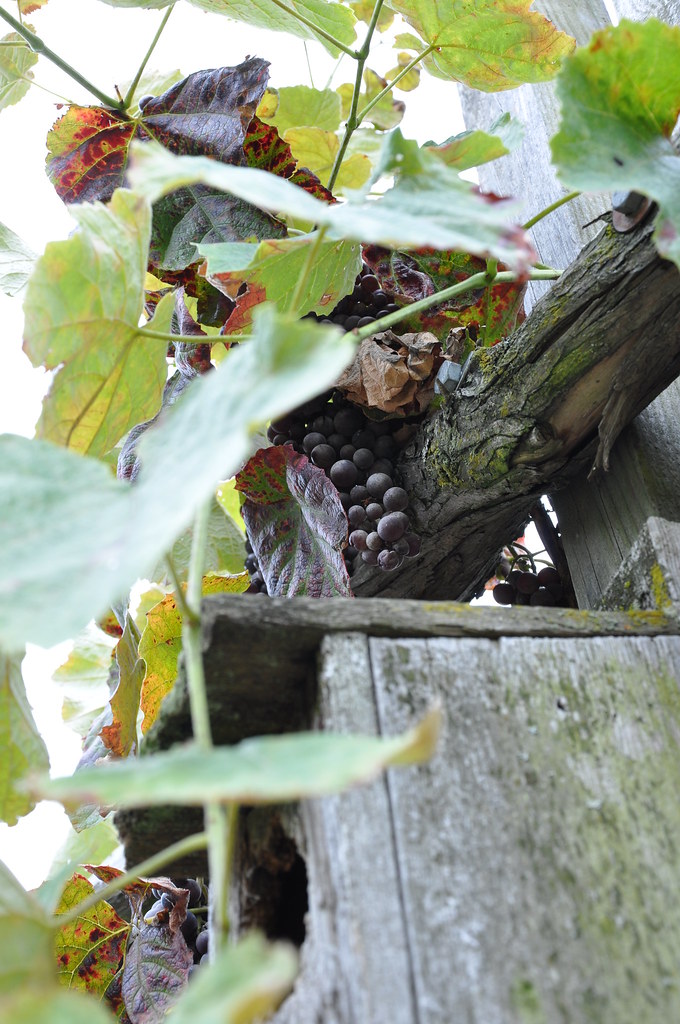This year the grapes were ripe right before we were due to go out of town for a week, so I picked them and then froze them, hoping that it would still work but setting my expectations fairly low in case it didn't. I figured with that handicap and the fact that our house is almost as cold as it is outside, I wasn't sure any yeast could survive, let alone thrive.
 |
| The starter in it's early home, by the oven. |
So I went ahead with all the steps. It wasn't too complicated, just sort of messy and delicate, also requiring a heaping helping of patience. The process takes about 2 weeks, from the day you crush your grapes to the day you bake you first loaf.
After those first 9 days is when it gets a little more time consuming. You have to feed the mixture 3 times a day--breakfast, lunch and dinner--with a rigid schedule of how long the bread can go without being fed. And you have to dump out a ton of mixture and start over with just a little over a pound every morning. This was the part I had the hardest time with. It's not in my nature to throw away pounds and pounds of perfectly good flour. One, we're pretty frugal around here, and two, I'm a pastry chef. Food waste is a huge sin in professional kitchens.
So I set out on a mission to use up as much of that dang starter as I could. I also tried to give a lot of it away, by offering starter batches to friends and people in our farm co-op. I think I ended up giving away 4 batches, and using the starter in an equal number of unexpected projects in the kitchen.
I made lots of cracker dough to freeze for entertaining over the holidays, with cayenne and olive oil. I used some to make sourdough waffles with apple cider. Eating those was like a little preview of heaven for foodies. And I made crumpets. Dozens of crumpets, two days in a row. Some of which we ate and the rest of which maxed out what was left of our freezer space.
What I can share is a very simple recipe for a salad. On Friday after making crumpets for what seemed like hours, we used them as our "challah" for a Shabbat dinner with our friend Aviva. Dinner ended up being sort of rushed, as she needed to be at the airport at 6:30, but it was still good to see a friend and share a meal, and to be able to enjoy some of the fruits of my hard work in the days leading up our meal.


The salad had endive, warm roasted beets and goat cheese and a dijon vinaigrette. That's it, the entire recipe. Really. I think it would be equally good with some butter lettuce or blue cheese. And I suppose you could really use any vinaigrette that you like. Whatever you have lying around really. The secret is that the beets should still be warm, so the cheese and the dressing really meld all together. That's what made it so fantastic.
I did finally get around to actually baking some real bread on Saturday--a rustic white bread, which I shaped into rolls for dipping in the minestrone I made that night. (More crust is totally better, right?) The bread was great. It rose slowly but had great oven spring, so I know my yeast is happy and healthy. Onto real challah this Friday!
Easy Dijon Vinaigrette
makes about 1 cup
1/4 cup extra virgin olive oil
1/4 cup balsamic vinegar
1/4 cup champagne vinegar
1 Tbsp or so sugar, honey or my favorite, pomegranate molasses
1 Tbsp good dijon mustard
1-2 cloves crushed garlic
salt and pepper to taste
Shake all the ingredients in a jar, adding more mustard if necessary to achieve a very smooth, emulsified texture. Taste for acidity and add more sweet if you like. I tend to like my pretty acidic and low on the oil. Keeps in the fridge for 2 weeks.












Wow- that is quite the project! Lovely vinaigrette too!
ReplyDelete